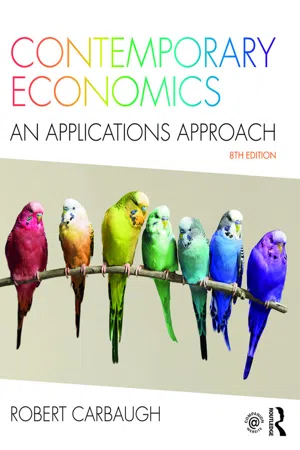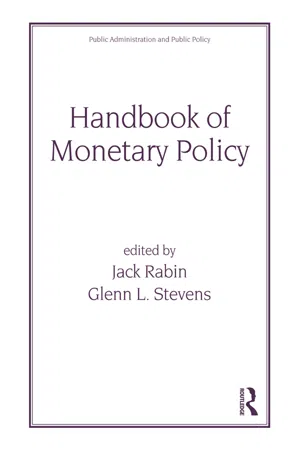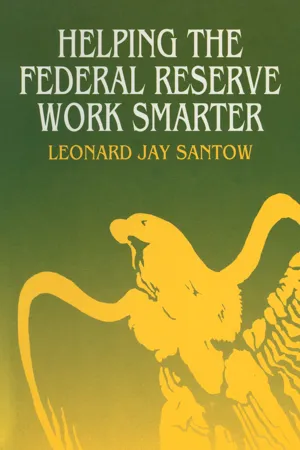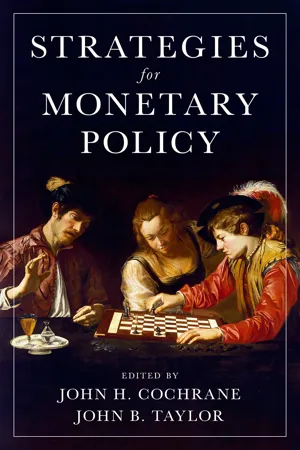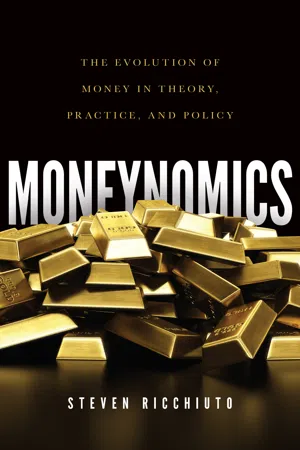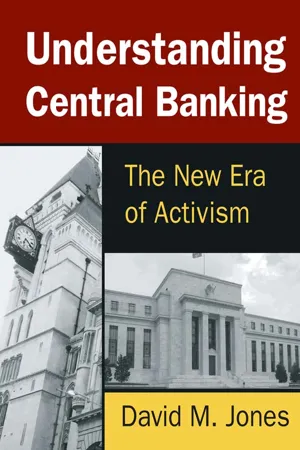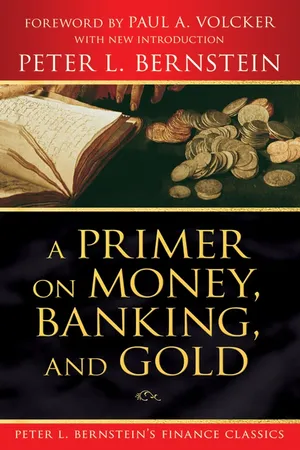Economics
Federal Funds
Federal funds refer to the reserves that banks are required to hold with the Federal Reserve. These funds are used to meet the reserve requirements and to settle interbank transactions. The Federal Reserve uses the federal funds rate to influence the overall level of interest rates in the economy.
Written by Perlego with AI-assistance
Related key terms
9 Key excerpts on "Federal Funds"
- No longer available |Learn more
Contemporary Economics
An Applications Approach
- Robert Carbaugh(Author)
- 2016(Publication Date)
- Routledge(Publisher)
Federal Funds market. Banks with surplus balances in their accounts transfer reserves to those needing to boost their balances.Typically, a Federal Funds transaction takes the form of an overnight loan. Arrangements are agreed upon by telephone between the lending bank and the borrowing bank and confirmed later by mail. The actual transfer of the reserves is normally accomplished by a phone call from the lending bank to the Federal Reserve Bank, instructing the latter to transfer the agreed-upon amount from its reserve account to that of the borrower. Generally, the Federal Reserve Bank will reverse the transaction on the following day.The Federal Reserve focuses monetary policy on the interest rate that it can best influence: the Federal Funds rate. The Federal Reserve targets the Federal Funds rate by controlling the amount of reserves supplied to the Federal Funds market. For example, an increase in the amount of reserves supplied to the Federal Funds market causes the funds rate to fall; a decrease in the supply of reserves raises that rate. Indeed, the Federal Funds rate closely reflects the basic supply and demand conditions in the market for bank reserves that are influenced by the Fed’s monetary policies. Therefore, analysts pay close attention to the Federal Funds rate for signals of change in monetary policy.Between meetings, the various members of the FOMC stay in touch through written and electronic correspondence. Moreover, an FOMC member talks daily with the Federal Reserve Bank of New York, which carries out the buying and selling of government securities. Telephone meetings of the entire FOMC may be called on very short notice, if necessary, and any member is free to object at any time to the manner in which the New York Federal Reserve Bank is carrying out the instructions of the FOMC. - eBook - ePub
- Jack Rabin(Author)
- 2020(Publication Date)
- Routledge(Publisher)
But this focus on the well-being of the national economy doesn’t mean that the Fed ignores regional economic conditions. Extensive regional data and anecdotal information are used, along with statistics that directly measure developments in the regional economy, to fit together a picture of the national economy’s performance. This is one advantage to having regional Federal Reserve Bank Presidents sit on the FOMC: They are in close contact with economic developments in their regions of the country.WHAT ARE THE TOOLS OF MONETARY POLICY?
The Fed can’t control inflation or influence output and employment directly; instead, it affects them indirectly, mainly by raising or lowering short-term interest rates. The Fed affects interest rates mainly through open market operations and the discount rate, and both of these methods work through the market for bank reserves, known as the Federal Funds market.What Are Bank Reserves?
Banks and other depository institutions (for convenience, we’ll refer to all of these as “banks”) are legally required to hold a specific amount of funds in reserve. These funds, which can be used to meet unexpected outflows, are called reserves, and banks keep them as cash in their vaults or as deposits with the Fed. Currently, banks must hold 3–10% of the funds they have in interest-bearing and non-interest-bearing checking accounts as reserves (depending on the dollar amount of such accounts held at each bank).What Is the Federal Funds Market?
From day to day, the amount of reserves a bank has to hold may change as its deposits change. When a bank needs additional reserves on a short-term basis, it can borrow them from other banks that happen to have more reserves than they need. These loans take place in a private financial market called the Federal Funds market.The interest rate on the overnight borrowing of reserves is called the Federal Funds rate or simply the “funds rate.” It adjusts to balance the supply of and demand for reserves. For example, an increase in the amount of reserves supplied to the Federal Funds market causes the funds rate to fall, while a decrease in the supply of reserves raises that rate. - eBook - ePub
- Leonard Jay Santow(Author)
- 2016(Publication Date)
- Routledge(Publisher)
These recommendations neither interfere with the free market mechanism nor attempt to reregulate. Rather, they endeavor to make an existing system and existing policy instruments more effective.The Federal Funds Rate
When one is looking at policy results from 1964 to 1993, one must examine several variables. The Federal Funds rate, the discount rate, discount window borrowings, required reserves, and M1 are especially important. These variables, when viewed as a package, reflect monetary policy during the three decades under review.Commercial banks buy and sell reserves on a daily basis. These transactions are referred to as the Federal Funds market, and the rate at which these funds trade is called the Federal Funds rate. Usually small banks and banks with large core deposits have excess reserves and will sell some of these funds to more aggressive banks that are in need of funds. If the less aggressive banks do not sell a significant amount of their excess reserves, the more aggressive banks will be short of funds, and the result will be an adverse distribution of funds in the banking system and a relatively high Federal Funds rate. The Fed usually adds reserves to the banking system to offset the adverse distribution.The funds rate can be strongly influenced by the Federal Reserve. The Fed can add reserves through repurchase agreements (RPs) using Treasury or agency securities as collateral, or through outright purchases of Treasury and agency securities. Repurchase agreements are a financing mechanism whereby a purchaser can buy debt securities and at the same time agree to sell them back at a later date, at a given price. The Fed can drain reserves by doing matched sales (reverse RPs), and by outright sales of Treasury and agency securities. It can also run off holdings of maturing issues.The central bank is incapable of attaining a desired average Federal Funds rate on a daily basis. In a given week, however, the Fed can usually come close—to within one-eighth of a percentage point. The Fed usually does better when targeting funds over a two-week bank statement period because unusual days for funds have the opportunity to average out. But when special situations occur, such as the end of a quarter, unexpected swings in Treasury balances at the Fed, or major surprises in factors affecting reserves, the average funds rate for a day, or several days, can be one percentage point or more away from the Fed's target. - eBook - ePub
Money, Banking, and Financial Markets
A Modern Introduction to Macroeconomics
- Dale K. Cline, Sandeep Mazumder(Authors)
- 2022(Publication Date)
- Routledge(Publisher)
Whenever the Fed begins to taper QE actions, talk of unwinding its bond purchases invariably occurs. Some believe that it will lead to economic instability or inflation. Since we understand that, because loan creation and the money supply is not affected by the size of the banking system’s reserve pool, we also understand that tapering QE will not lead to inflation. However, the markets may react to perceived changes in Fed policy and that may lead to instability. Therefore, the Fed must use caution and employ various tools to control the Fed funds rate as it alters its program. The interest paid on excess reserves allows the Fed to control the rate more accurately and quickly. Effectively serving as the lower boundary, the interest rate paid on reserves serves makes it easier to fine tune the rate, providing the ability to make adjustments without changing the levels of reserves.Velocity and other economic indicators
Economists define the money supply in terms of layers which build successively upon each other, moving from the most liquid to the least. The most-narrow layer, called the monetary base, includes actual cash in circulation and reserve accounts at the central bank, while the broad category of M3 encompasses larger, longer-term deposits, including institutional funds. M2 includes all notes and coins in circulation, cash equivalents and cash accounts except for time deposits of $100,000 or more, so it is fairly representative of the currency available to us to carry out our daily activities. But why does keeping a measure of the money supply matter? Well, many economists believe that the size of our money supply can be used as one guide to understanding and predicting both short-term economic variables as well as longer-term movements such as inflation, helping Fed officials to determine the appropriate course of action in terms of monetary policy.To view the money supply as an economic indicator, one must recognize that it should be expressed in terms of its relationship to other economic measures. For example, based on U.S. quarterly data from 1981 to 2019, M2 multiplied by approximately 1.8 equals the Gross Domestic Product (GDP), with GDP being defined as the total output of goods and services for, typically, a 1-year period. Figure 5.4 - eBook - ePub
- John H. Cochrane, John B. Taylor(Authors)
- 2020(Publication Date)
- Hoover Institution Press(Publisher)
Under our fiat money system, this institutional arrangement is embodied by the Federal Reserve. It is up to the Fed to conduct monetary policy in a way that pins down the aggregate nominal price level. The Fed achieves this goal by exercising its monopoly control over the supply of base money: currency plus bank reserves.Today, as before the crisis, the Fed implements monetary policy by targeting the Federal Funds rate. The Federal Funds rate, however, is a market rate of interest, charged by one bank to another on a very short-term loan of reserves. The Fed does not set the funds rate directly. Instead, the Fed’s operating procedures must link the Federal Funds rate, which the Fed can only influence, to the monetary base, which the Fed can precisely control.Before the financial crisis of 2007– 2008, the link between the funds rate and the supply of base money was more immediate and therefore more obvious. Whenever the Fed wanted to lower its target for the funds rate, it conducted an open market purchase, buying US Treasury securities to inject new reserves into the banking system. The increased supply of bank reserves put downward pressure on the equilibrium funds rate, moving it lower in line with the new target. Conversely, whenever the Fed wanted to raise its target for the funds rate, it conducted an open market sale of US Treasury securities to drain reserves from the banking system and put upward pressure on the funds rate.Since December 2015, however, the Fed has gradually lifted its Federal Funds rate target off its zero lower bound using a floor system. Under this floor system, the Fed uses its newly granted ability to pay interest on reserves to manipulate the Federal Funds rate, without having to conduct open market operations right away. By raising the interest rates paid to banks on reserves and nonbank financial intermediaries on reserve repurchase agreements, the Fed has successfully moved the Federal Funds rate up in lockstep. And, presumably, when the next easing cycle begins, the Fed will lower the interest rates on reserves and reverse repurchase agreements to bring the Federal Funds rate back down. - eBook - ePub
Moneynomics
The Evolution of Money in Theory, Practice, and Policy
- Steven Ricchiuto(Author)
- 2020(Publication Date)
- Greenleaf Book Group Press(Publisher)
Besides these temporary additions and subtractions, the Fed can permanently add or subtract reserves from the banking system through outright purchase and sales of government-backed debt. One additional source of reserves to the banking system provided through the Federal Reserve is the discount window. The discount window is a vehicle for banks to temporarily borrow reserves from the Fed for a fee, or the discount rate. The supply of reserves is critical to determining the level of money available in the economy at each level of the interest rate or level of the Fed funds rate. The Fed funds rate is the base rate for unsecured overnight lending between banks, and it forms the base rate for all other borrowing. The supply of reserves available to the banking system is set by the Federal Reserve. The makers of monetary policy inject a certain level of nonborrowed reserves into the system through the purchase of assets and the liabilities that they accrue. A big chunk of the Fed’s assets are its holdings of Treasury securities and other government-backed debt held on its balance sheet, either permanently or temporarily. Beyond the level of nonborrower reserves are those the Fed provided through the discount window, as discussed earlier. The biggest liabilities on the Fed’s balance sheet are the level of Federal Reserve notes circulating in the economy and stored in its bank vaults. Discount window. Banks can borrow from the discount window under three separate programs offered by the Federal Reserve: primary credit program, secondary credit program, and seasonal credit. At this time, we are most interested in the primary credit program. It is typically an overnight loan to a healthy financial institution to help it better manage its reserve balances. The secondary credit program is designed for financial institutions that are experiencing a liquidity issue caused by a significant financial difficulty - eBook - ePub
Understanding Central Banking
The New Era of Activism
- David Jones(Author)
- 2014(Publication Date)
- Routledge(Publisher)
Monetary officials maintain an unchanged Federal Funds rate target of, say, 4.5 percent on a day-to-day basis by making adjustments in the supply of nonborrowed reserves through routine open market purchases (sales) of securities; other factors affecting bank reserves such as float and adjustments in Treasury Tax and Loan Accounts held at the Fed are also taken into account. When the Fed is seeking to keep its Federal Funds rate target unchanged, the monetary officials will assume a defensive posture in their open market operations, merely supplying enough reserves through open market bond purchases (or more nuanced temporary repurchase agreements) to offset the impact of other factors draining bank reserves. An increase in Treasury Tax and Loan Accounts might, for example, be the factor draining reserves. If the monetary authorities wish to tighten reserve market conditions and increase their funds rate target, they assume an “offensive” posture in their open market operations in an effort to reduce the supply of nonborrowed reserves through open market sales of securities held on the Fed’s balance sheet (or more nuanced reverse repurchase agreements). Conversely, if Fed officials seek to ease reserve market conditions and reduce their funds rate target, they purchase securities to add to their balance sheet (or engage in more nuanced repurchase agreements), thereby increasing the supply of nonborrowed reserves. Note that nonborrowed reserves equal total reserves minus borrowed reserves. Borrowed reserves, in turn, are reserves borrowed at the Fed’s discount window by banks.The point is that the Fed’s “conventional” operations involving adjustments in its Federal Funds rate target have been more or less routine during most of the post–1951 Accord period, with the monetary policymakers’ purpose being, in effect, to directly influence other short- and long-term interest rates, asset prices, and the dollar in order to ultimately affect aggregate demand, output, and employment.But once the nominal Federal Funds rate reached its lower bound of zero in the epic central bank fight to counter the negative economic impact of the debt crisis, an entirely new world of unprecedented central bank activism was upon us. It came in the form of massive, innovative, improvised, and seemingly unlimited “unconventional” central bank accommodative actions, using the central bank balance sheet as the new policy instrument. In this new world, central bank liquidity appears to trump all other factors.FED “UNCONVENTIONAL ” EASINGAs an academic, Fed chairman Bernanke studied the Great Depression. His research revealed that the Fed stood by and did very little as the U.S. economy sank into a deepening depression during the period between1929 and 1933. In an effort to avoid the Fed’s glaring mistake of more than eight decades ago, the Bernanke Fed surprised the financial markets in announcing (following its December 15–16, 2008, FOMC meeting) that it intended to resort to “unconventional” easing, breaking the bonds of orthodoxy and launching a new era of central bank activism. In fighting the Great Credit Crisis of 2007–2009, which had been under way for more than a year and worsened dramatically following the unfortunate bankruptcy of Lehman Brothers on September 15, 2008, the Fed had already used up most of its conventional policy ammunition, cutting its Federal Funds rate target to 1 percent by the end of October 2008 from 5.25 percent in September 2007. - eBook - ePub
Central Bank Autonomy
The Federal Reserve System in American Politics
- Kevin Corder(Author)
- 2014(Publication Date)
- Routledge(Publisher)
CHAPTER 3 Reserve Requirements and the Distribution of Monetary RestraintReserve requirements specify the percentage of commercial bank liabilities that must be held at the Federal Reserve regional banks in order to meet demands of depositors or other claims against commercial banks. The requirements obligate a financial institution to place funds in a reserve account at a regional Federal Reserve Bank. Since the reserve accounts yield no interest, financial institutions realize no return on bank assets that serve as reserves. Any profits generated by the investment of the contents of these reserve accounts in government securities is held by the Fed, so reserve requirements redistribute revenue from commercial banks to the regional Federal Reserve Banks. Required reserves therefore function as an implicit tax on the financial institutions to which they apply.Studies of monetary policy outcomes by political scientists and political economists typically have as a singular focus the extent to which central bank policies expand or contract the aggregate supply of credit and money available to finance economic activity. Indicators of expansion and contraction include aggregate nonborrowed commercial bank reserves, the Federal Funds rate, and the narrow money aggregate (M1). In this context, reserve requirements are either high (meaning tighter money) or low (meaning easier money). Little attention is given to variation in the scope and definition of required reserves. This omission is surprising given the distributive implications of changes in reserve requirements. Since the structure of reserve requirements determines the distribution of an implicit tax burden across types and classes of financial institutions, changes in reserve requirements are ultimately redistributive choices. It would seem to matter to both commercial bankers and elected officials whether or not, for instance, bank holdings other than deposits at a Federal Reserve Bank can be counted as cash reserves. Banks that routinely hold large amounts of vault cash, at one time characteristic of rural banks, would be disadvantaged if those assets could not be counted as reserves. Since important redistributive effects accompany changes in reserve requirements, these changes should attract considerable attention from members of Congress. Reserve requirements determine what types of financial institutions are most directly affected by monetary restraint and what types of borrowers face the dearest interest rate premiums when monetary policy is tightened. Elected officials are likely to have preferences over how monetary policy is distributed across the economy, so reserve requirements could be a focus of efforts by elected officials to influence monetary policy outcomes. Fed policy makers, reflecting a systematic strategy of avoiding congressional intervention in monetary policy choices, consistently rely on indirect rules and administrative updates (rather than statutory instructions) to manage reserve requirements. - Peter L. Bernstein(Author)
- 2008(Publication Date)
- Wiley(Publisher)
To use a technical term, the liquidity of the economy has increased: people are holding more money than they had been holding, and those who need cash find it easier to raise through selling securities or finding a willing lender. Although this situation in itself gives no assurance that individuals or business firms will use this additional liquidity to go out and buy more goods and services than they had been buying (which presumably was the objective that motivated the Federal Reserve open-market purchases in the first place), money ultimately does begin to burn a hole in most people’s pockets. Furthermore, any increased demand for goods and services that does develop can now be much more readily financed.When, on the other hand, the Reserve Banks are sellers of securities, they must find investors willing to buy; this means they must offer securities at prices lower than those currently prevailing. Furthermore, the banks in which the buyers of the securities maintain their accounts will lose reserves and will also have to sell securities (or refrain from buying them). By offering securities at lower prices, then, the Reserve Banks and the commercial banks are in effect persuading investors to part with money and to take securities instead. And this trend spreads throughout the financial community. With Government bonds at lower prices, lesser quality bonds and common stocks look more expensive than they had previously appeared, and their prices tend to drop as well. Individuals and businessmen needing cash find it more difficult to raise and are more reluctant to increase their spending for goods and services.They may even be forced to retrench their activities.Through this complicated, frequently tortuous, and occasionally unpredictable process, the monetary authorities attempt to influence the ease or difficulty with which those who need money can finance their expenditures or satisfy their desires for liquidity. The hope and expectation is that, through this process in turn, the authorities will be able to influence the level of business activity and the trend of prices. But merely making it easier for people to raise money or making it more attractive for them to part with money in exchange for securities may not be enough to induce the rate of spending to rise or to fall: people may be reluctant to spend this additional money or, in the opposite case, may still be able to finance their expenditures without too much trouble. We shall see in subsequent chapters the extent to which this process actually works.
Index pages curate the most relevant extracts from our library of academic textbooks. They’ve been created using an in-house natural language model (NLM), each adding context and meaning to key research topics.
